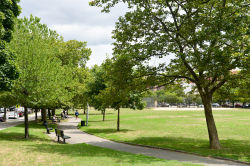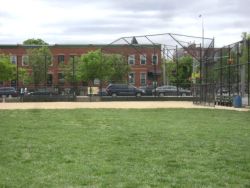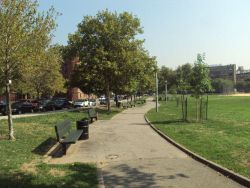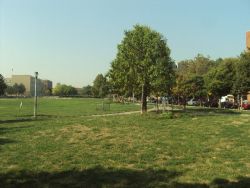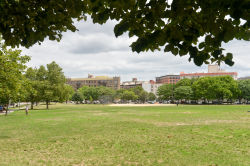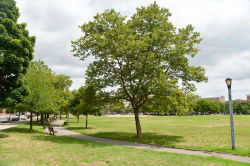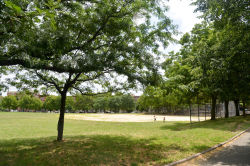Bill Rainey Park
Bill Rainey Park
What was here before?
The site was to be the Queens anchorage of the Blackwell Island Bridge linking Queens and Manhattan, named so for its midpoint on Blackwell Island (now Roosevelt Island). The project backed by citizens of Long Island City after the American Civil War, who in 1871 incorporated the New York and Queens County Bridge Company. The bridge, planned with one ramp south to Brooklyn and another out to Long Island, was promoted as a catalyst for developing growth in Queens and as a railroad link to Long Island. Ultimately, the effort fell apart during the financial Panic of 1873.
Efforts were renewed the following year, under the company’s then-treasurer Dr. Thomas Rainey, who became the organization’s president in 1877. Despite Dr. Rainey’s lobbying, the War Department withheld approval amidst concern that a bridge could interfere with the defense of New York and access to the Brooklyn Navy Yard. The project had lost steam by 1892, attributable to the sparse population in Queens and a greater desire for a bridge connecting Brooklyn and Manhattan.
After the consolidation of New York City in 1898, the project for a bridge between Queens and Manhattan gained new momentum, resulting in the construction of the Queensboro Bridge several blocks south.
How did this site become a park?
On April 18, 1904, the City of New York acquired by condemnation several acres of waterfront property belonging to property owners Florence O.H. Antony, Libbie Devlin, and Dr. S.T.W. Sanford. A concrete sea wall was completed in 1912, and an exchange of properties with local landowners James J. and Elizabeth W. Herman in 1917 added nearly three acres to the northern part of the park.
The bronze and granite Ravenswood War Memorial stood in the park from 1921 to 1967, when the stele was stolen. The bronze tablet was recovered, consigned and installed on the exterior wall of St. Rita's School (now P.S. 83) in 1971. The monument’s base was removed around 1985.
During the construction of a new store abutting the park in 1996, Costco made improvements to the landscaping and fencing at the very northern border of the park. Around 2008, new mounded play features referencing the whimsical playground designs of sculpture Isamu Noguchi were added. A museum dedicated to his work is located opposite the park.
A project completed in 2013 constructed a portion of the Queens East River and North Shore Greenway in Rainey Park and several other waterfront parks in Queens, which included upgrades to existing facilities and increased waterfront access. In 2024, the park was reconstructed with improvements to the playground, picnic grove and basketball court, as well as a rerouting of and expanded entrance to the Greenway, and removal of the 2008 play mounds.
Who is this park named for?
Dr. Thomas Rainey (1824-1910), a resident of Ravenswood, spent 25 years of his life and most of his fortune advancing the construction of a bridge across the East River between Manhattan and Long Island City.
A year before his death, Dr. Rainey realized his dream as he crossed the new Queensboro Bridge with Governor Charles Evans Hughes (1862-1948) on opening day. Rainey received a gold medal inscribed “The Father of the Bridge.” On that day Rainey told the New York Times, “This is my bridge. At least it is the child of my thought, of my long years of arduous toil and sacrifice. Just over there, are the old towers of my bridge, which I began to build many years ago. I spent all I owned on the project . . . It is a grand bridge, much greater than the one I had in mind. It will be in service to thousands in the years to come, when Dr. Rainey and his bridge projects will long have been gathered into the archives of the past.”
Rainey’s pride in the structure was so great that before his death at age 86, he reportedly attempted to walk the length of the bridge.
Check out your park's Vital Signs
Clean & Safe
Green & Resilient
Empowered & Engaged Users
Share your feedback or learn more about how this park is part of a
Vital Park System

